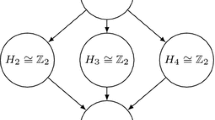Abstract
Cellular automata are synchronous discrete dynamical systems used to describe complex dynamic behaviors. The dynamic is based on local interactions between the components, these are defined by a finite graph with an initial node coloring with two colors. In each step, all nodes change their current color synchronously to the least/most frequent color in their neighborhood and in case of a tie, keep their current color. After a finite number of rounds these systems either reach a fixed point or enter a 2-cycle. The problem of counting the number of fixed points for cellular automata is #P-complete. In this paper we consider cellular automata defined by a tree. We propose an algorithm with run-time \(O(n\varDelta )\) to count the number of fixed points, here \(\varDelta \) is the maximal degree of the tree. We also prove upper and lower bounds for the number of fixed points. Furthermore, we obtain corresponding results for pure cycles, i.e., instances where each node changes its color in every round. We provide examples demonstrating that the bounds are sharp.
Access this chapter
Tax calculation will be finalised at checkout
Purchases are for personal use only
Similar content being viewed by others
References
Agur, Z.: Fixed points of majority rule cellular automata with application to plasticity and precision of the immune system. Complex Syst. 5(3), 351–357 (1991)
Agur, Z., Fraenkel, A., Klein, S.: The number of fixed points of the majority rule. Discret. Math. 70(3), 295–302 (1988)
Akutsu, T., Kuhara, S., Maruyama, O., Miyano, S.: A system for identifying genetic networks from gene expression patterns produced by gene disruptions and overexpressions. Genome Inform. 9, 151–160 (1998)
Aledo, J.A., Diaz, L.G., Martinez, S., Valverde, J.C.: Enumerating periodic orbits in sequential dynamical systems over graphs. J. Comput. Appl. Math. 405, 113084 (2022)
Aracena, J.: Maximum number of fixed points in regulatory Boolean networks. Bull. Math. Biol. 70(5), 1398 (2008)
Aracena, J., Richard, A., Salinas, L.: Maximum number of fixed points in and-or-not networks. J. Comput. Syst. Sci. 80(7), 1175–1190 (2014)
Barrett, C., et al.: Predecessor existence problems for finite discrete dynamical systems. Theoret. Comput. Sci. 386(1–2), 3–37 (2007)
Bridoux, F., Durbec, A., Perrot, K., Richard, A.: Complexity of fixed point counting problems in Boolean networks. J. Comput. Syst. Sci. 126, 138–164 (2022)
Goles, E., Olivos, J.: Periodic behaviour of generalized threshold functions. Discret. Math. 30(2), 187–189 (1980)
Irons, D.: Improving the efficiency of attractor cycle identification in Boolean networks. Physica D 217(1), 7–21 (2006)
Kauffman, S., et al.: The origins of order: Self-organization and selection in evolution. Oxford University Press, USA (1993)
Královič, R.: On majority voting games in trees. In: Pacholski, L., Ružička, P. (eds.) SOFSEM 2001. LNCS, vol. 2234, pp. 282–291. Springer, Heidelberg (2001). https://doi.org/10.1007/3-540-45627-9_25
Mezzini, M., Pelayo, F.L.: An algorithm for counting the fixed point orbits of an and-or dynamical system with symmetric positive dependency graph. Mathematics 8(9), 1611 (2020)
Mishra, S., Rao, S.: Minimum monopoly in regular and tree graphs. Discret. Math. 306(14), 1586–1594 (2006). https://doi.org/10.1016/j.disc.2005.06.036
Moran, G.: The r-majority vote action on 0–1 sequences. Discr. Math. 132(1–3), 145–174 (1994)
Nakar, Y., Ron, D.: The structure of configurations in one-dimensional majority cellular automata: from cell stability to configuration periodicity. In: Chopard, B., Bandini, S., Dennunzio, A., Arabi Haddad, M. (eds.) 15th International Conference on Cellular Automata. LNCS, vol. 13402, pp. 63–72. Springer, Cham (2022). https://doi.org/10.1007/978-3-031-14926-9_6
Papp, P., Wattenhofer, R.: Stabilization time in minority processes. In: 30\(^{th}\) International Symposium on Algorithms & Computation. LIPIcs, vol. 149, pp. 43:1–43:19 (2019)
Peleg, D.: Local majorities, coalitions and monopolies in graphs: a review. Theoret. Comput. Sci. 282(2), 231–257 (2002)
Poljak, S., Sura, M.: On periodical behaviour in societies with symmetric influences. Combinatorica 3(1), 119–121 (1983)
Rouquier, J., Regnault, D., Thierry, E.: Stochastic minority on graphs. Theoret. Comput. Sci. 412(30), 3947–3963 (2011)
Tošić, P.T., Agha, G.A.: On computational complexity of counting fixed points in symmetric boolean graph automata. In: Calude, C.S., Dinneen, M.J., Păun, G., Pérez-Jímenez, M.J., Rozenberg, G. (eds.) UC 2005. LNCS, vol. 3699, pp. 191–205. Springer, Heidelberg (2005). https://doi.org/10.1007/11560319_18
Turau, V.: Fixed points and 2-cycles of synchronous dynamic coloring processes on trees. In: Parter, M. (eds.) 29\(^{th}\) International Colloquium on Structural Information and Communication Complexity - Sirocco. pp. 265–282. Springer, Cham (2022). https://doi.org/10.1007/978-3-031-09993-9_15
Turau, V.: Counting Problems in Trees, with Applications to Fixed Points of Cellular Automata. arXiv preprint arXiv:2312.13769 (2023)
Veliz-Cuba, A., Laubenbacher, R.: On the computation of fixed points in Boolean networks. J. Appl. Math. Comput. 39, 145–153 (2012)
Zehmakan, A.: On the Spread of Information Through Graphs. Ph.D. thesis, ETH Zürich (2019)
Author information
Authors and Affiliations
Corresponding author
Editor information
Editors and Affiliations
Rights and permissions
Copyright information
© 2024 The Author(s), under exclusive license to Springer Nature Switzerland AG
About this paper
Cite this paper
Turau, V. (2024). Counting Fixed Points and Pure 2-Cycles of Tree Cellular Automata. In: Soto, J.A., Wiese, A. (eds) LATIN 2024: Theoretical Informatics. LATIN 2024. Lecture Notes in Computer Science, vol 14579. Springer, Cham. https://doi.org/10.1007/978-3-031-55601-2_16
Download citation
DOI: https://doi.org/10.1007/978-3-031-55601-2_16
Published:
Publisher Name: Springer, Cham
Print ISBN: 978-3-031-55600-5
Online ISBN: 978-3-031-55601-2
eBook Packages: Computer ScienceComputer Science (R0)




